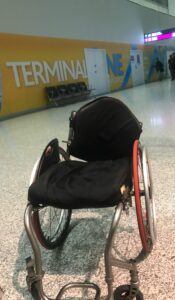Airline travel can be stressful for anyone, especially for a person with a disability. Disabled travelers have the usual concerns, such as scheduling and connections, but also the additional concern about the safety of their mobility equipment.
Worldwide, airlines have a poor record for safely transporting mobility equipment. Disabled passengers are injured or have their mobility devices damaged hundreds of times each year.
In my view, this can be explained with the understanding that the airlines treat mobility devices like luggage. If equipment is damaged, you are sent to the lost and/or damaged baggage department to complete a form, as if it were a missing suitcase, rather than a vital piece of medical equipment. Disabled passengers and their mobility devices are treated like inconvenient, oversized luggage.
For the disabled traveler, this means arriving at their destination without the one piece of equipment that keeps them mobile, comfortable, safe, and independent.
For the non-disabled traveler, it is the equivalent of having the airline break both of your legs during your flight.
Unfortunately, I’ve learned this from experience.
During my travels, I’ve had my wheelchair damaged countless times by various airlines.
This includes one incident on an Air Canada flight, where my wheelchair was damaged beyond repair. My wheelchair was replaced, but the entire process took more than four months to resolve. This incident had a serious impact on my physical and mental health.
The issue has come to the fore following four dangerous incidents, all related to Air Canada. These incidents prompted Transport Minister Pablo Rodriguez to summon Air Canada officials to Ottawa. Minister Rodriquez said he was“horrified” by the incidents. Rodriquez has called on Air Canada to present a comprehensive plan for serving disabled passengers. Adding that airlines will be held accountable.
For years, the disability community has been calling for airlines worldwide to provide a safer system for transporting mobility equipment — particularly wheelchairs and scooters.
A safer system, we believe, would require that mobility devices be placed in a safety container, before being put into the hold of an aircraft. Better yet, aircraft should be configured so that passengers can remain in their wheelchairs. This eliminates the need for perilous transfers and reduces the likelihood of equipment damage, leaving the passenger seated safely and comfortably.
As expected, following the meeting in Ottawa, Air Canada apologized, promising improvements. This rings hollow. Calls for the respectful and dignified treatment of disabled passengers have been repeated for decades, by the passengers themselves and by regulators. The calls have been answered with performative apologies and limited action.
Providing an accessible service, grounded in dignity and respect, is good business. If that principle is not enough to bring meaningful change, stronger regulation, including stiff penalties for noncompliance, is the only solution.
Whichever solution is chosen, all airlines have a lot of work ahead to regain the trust of disabled passengers.




